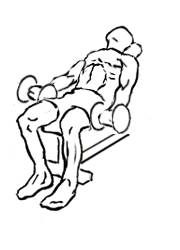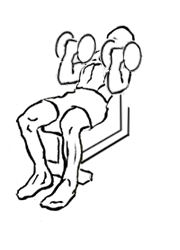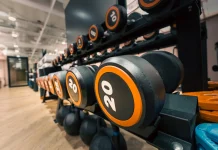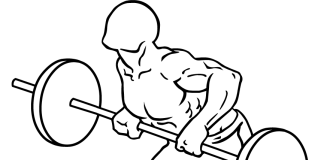Last Updated on September 30, 2014
The Flexor Incline Curls with Dumbbell is an excellent exercise that targets the biceps while emphasizing control and isolation. This movement is performed on an incline bench, allowing for a longer range of motion and better stretch at the bottom of the curl, which engages the biceps more effectively. Unlike traditional standing curls, incline curls work to eliminate the assistance of momentum, forcing your biceps to do all the work. As a result, this exercise is one of the best for building strength, size, and definition in the biceps.
In this blog, we’ll explore the benefits of the Flexor Incline Curls with Dumbbell, break down the proper technique, highlight common mistakes, and provide variations to help you get the most out of your biceps workout. Whether your goal is to build bigger arms, improve strength, or enhance muscle definition, the Flexor Incline Curls with Dumbbell can help you achieve those results.
Why Do Flexor Incline Curls?
The Flexor Incline Curls with Dumbbell offers several key benefits that make it an essential exercise for anyone looking to develop their biceps. Here’s why this exercise should be part of your arm training:
- Better Biceps Isolation: When performing traditional standing curls, it’s easy to involve other muscles like the shoulders and back to help lift the weight. However, the incline position used in Flexor Incline Curls prevents you from using momentum, forcing your biceps to carry the entire load. This isolation leads to better engagement and faster muscle growth.
- Increased Range of Motion: The incline bench position allows your arms to extend further behind your body, providing a greater stretch at the bottom of the movement. This increased range of motion targets the long head of the biceps more effectively, helping to build the overall peak and shape of the muscle.
- Constant Tension on the Biceps: With your arms positioned behind your body, the biceps remain under constant tension throughout the entire movement. This continuous stress enhances muscle hypertrophy (growth) and ensures that the biceps are being worked from start to finish.
- Improved Muscle Control: Because the incline position eliminates momentum, you’ll need to focus on controlling the movement from beginning to end. This improved control helps strengthen the mind-muscle connection, allowing you to better feel and engage the biceps during each rep.
- Reduced Strain on the Wrists and Shoulders: Incline curls are easier on the wrists and shoulders compared to standing curls or barbell curls. The dumbbells allow for a more natural grip, reducing the risk of strain or injury to these joints.
- Promotes Muscle Symmetry: Performing curls with dumbbells ensures that each arm works independently. This is important for addressing muscle imbalances and promoting symmetry in your biceps, as both arms must lift the same weight without relying on the other for support.
Muscles Worked in Flexor Incline Curls
While the Flexor Incline Curl with Dumbbell primarily targets the biceps, several other muscles are also engaged to stabilize the movement and provide support. Here’s a breakdown of the muscle groups involved:
- Biceps Brachii: The primary muscle worked during this exercise is the biceps brachii, which is responsible for flexing the elbow and supinating the forearm. This muscle has two heads—the long head (which helps create the peak of the biceps) and the short head. Incline curls emphasize the long head, helping to improve the overall shape and definition of the biceps.
- Brachialis: The brachialis is a smaller muscle located beneath the biceps. It assists in elbow flexion and contributes to the thickness of the upper arm. Strengthening the brachialis helps push the biceps up, making your arms look fuller and more defined.
- Forearms: The forearm muscles, particularly the brachioradialis, are engaged during this exercise as you grip the dumbbells and control the weight throughout the movement. Stronger forearms improve your ability to perform other exercises and lifts.
- Core and Stabilizers: Although the focus is on the biceps, your core and other stabilizing muscles (such as the deltoids and rotator cuffs) are engaged to maintain proper posture and form throughout the exercise. This helps prevent unwanted movement and keeps the focus on the biceps.
Step-by-Step Guide to Performing Flexor Incline Curls with Dumbbells
Equipment Needed:
- Incline Bench: Set the bench at a 45-degree angle to ensure you get a good stretch at the bottom of the curl.
- Dumbbells: Choose a weight that allows you to complete the exercise with proper form. Start light if you’re new to the movement and gradually increase the load as your strength improves.
Starting Position:
- Set Up on the Incline Bench: Sit back on an incline bench with your feet planted firmly on the ground. Your back should be flat against the bench, and your arms should hang down at your sides, fully extended. This position ensures your biceps are fully stretched at the start of the exercise.
- Grasp the Dumbbells: Hold a dumbbell in each hand with your palms facing up (supinated grip). Keep your wrists straight and your arms relaxed at your sides.
- Engage Your Core: Before you begin, engage your core muscles to help stabilize your torso and prevent excessive movement during the exercise.
The Movement:
- Curl the Dumbbells Up: Begin by slowly curling the dumbbells toward your shoulders. Keep your elbows stationary and tucked close to your sides—your upper arms should not move. As you lift the weights, focus on squeezing your biceps and maintaining control of the movement.
- Squeeze at the Top: Once the dumbbells reach shoulder height, pause for a moment and squeeze your biceps at the top of the movement. This peak contraction is where the biceps are fully engaged, so take a brief moment to maximize muscle activation.
- Lower the Dumbbells Slowly: In a slow and controlled manner, lower the dumbbells back down to the starting position. Avoid letting your arms drop too quickly—controlling the lowering phase helps build muscle and prevent injury.
- Repeat: Perform 8–12 repetitions, depending on your strength level and the weight you’re using. Aim for 3–4 sets to effectively work the biceps and build arm strength.
Tips for Proper Form and Technique
To maximize the benefits of the Flexor Incline Curls with Dumbbell, it’s essential to use proper form and technique. Here are some key tips to ensure you’re performing the exercise correctly:
- Keep Your Elbows Stationary: One of the most common mistakes is allowing the elbows to move forward during the curl. Your elbows should remain close to your torso and stay stationary throughout the entire movement. This ensures that the biceps are doing all the work.
- Avoid Using Momentum: The incline position is designed to eliminate momentum, but it’s still important to focus on controlled movements. Avoid swinging the dumbbells or using your back to lift the weight. Instead, rely on your biceps to perform the curl.
- Maintain a Full Range of Motion: Lower the dumbbells until your arms are fully extended at the bottom of the movement, and bring them up to shoulder height at the top. This full range of motion ensures that the biceps are fully stretched and contracted during each rep.
- Don’t Lock Out Your Elbows: While you should lower the dumbbells until your arms are fully extended, avoid locking out your elbows. Keeping a slight bend in your elbows helps maintain tension on the biceps and prevents joint strain.
- Control the Eccentric Phase: The lowering phase (eccentric) of the curl is just as important as the lifting phase. Lower the dumbbells slowly and with control to maximize muscle engagement and prevent injury.
Common Mistakes to Avoid
Here are some common mistakes people make when performing Flexor Incline Curls, along with tips on how to avoid them:
- Moving the Elbows Forward: Allowing the elbows to drift forward during the curl reduces the effectiveness of the exercise and shifts the focus away from the biceps. Keep your elbows stationary throughout the movement to ensure proper bicep activation.
- Lifting Too Heavy: Using weights that are too heavy can compromise your form and lead to injury. Start with a weight that allows you to complete each rep with proper technique, and gradually increase the load as your strength improves.
- Not Engaging the Core: Failing to engage your core can lead to poor posture and unnecessary strain on your lower back. Always keep your core tight and your back flat against the bench to maintain stability.
- Rushing Through Reps: Performing the exercise too quickly reduces muscle engagement and increases the risk of injury. Focus on slow, controlled movements to get the most out of each rep.
- Neglecting the Eccentric Phase: Many lifters focus solely on the lifting phase and neglect the importance of the lowering phase. Lowering the dumbbells slowly and with control is crucial for maximizing muscle growth and preventing injury.
Variations of Flexor Incline Curls
To keep your workouts fresh and challenging, try incorporating some of these variations of the Flexor Incline Curl into your routine:
- Hammer Incline Curls: Instead of using a supinated grip, perform the exercise with a neutral (palms facing each other) grip. This variation emphasizes the brachialis and brachioradialis, helping to build thickness in the arms.
- Alternating Incline Curls: Perform the curls one arm at a time. This variation increases focus on each bicep individually and helps improve muscle symmetry. By alternating arms, you can ensure that each bicep is being worked to its full potential, which is especially beneficial if you have any imbalances between your left and right sides.
- Incline Curl with Resistance Bands: To add more resistance throughout the range of motion, use resistance bands in place of dumbbells. Attach the bands to a low anchor point behind the bench and perform the curls as usual. The bands provide constant tension, which can help increase muscle activation, particularly at the top of the movement.
- Incline Cable Curls: This variation uses a cable machine instead of dumbbells, which provides continuous tension throughout the exercise. Attach a cable to a low pulley, set the bench at an incline, and curl the cable in the same motion as you would with a dumbbell. The constant tension from the cables makes this variation especially effective for muscle hypertrophy.
- Incline Curl with a Twist: Perform the traditional incline curl but add a twist to your wrist at the top of the movement. Start with a supinated grip, and as you raise the dumbbells, rotate your wrists outward (as if you’re pouring out water). This twist adds more engagement to the forearms and biceps, giving you an extra challenge.
- Incline Preacher Curl: For an even more focused bicep contraction, try combining the incline curl with a preacher bench. Sit on the incline bench, but instead of letting your arms hang down by your sides, rest them on a preacher pad. This variation reduces the ability to use momentum, forcing the biceps to work harder through the full range of motion.
How to Incorporate Flexor Incline Curls into Your Routine
The Flexor Incline Curl with Dumbbells can be incorporated into various workout routines, whether you’re focusing on bicep growth or overall arm strength. Here are some ways to include it effectively:
- Biceps-Focused Day: If you’re dedicating a workout to building your biceps, the Flexor Incline Curl should be one of your key exercises. Pair it with other bicep-focused movements like hammer curls, concentration curls, and preacher curls for a comprehensive arm workout.
- Upper Body Workouts: When training your upper body, include Flexor Incline Curls alongside exercises that target your chest, back, and shoulders. For example, after performing compound lifts like bench presses and rows, use incline curls as an isolation exercise to fully engage the biceps.
- Supersets and Circuits: To increase the intensity of your workout, combine Flexor Incline Curls with other arm or upper-body exercises in supersets or circuits. For example, you can alternate between incline curls and tricep dips or pair incline curls with dumbbell shoulder presses. This approach will keep your muscles under tension for longer, promoting strength and endurance.
- Full-Body Workouts: If you’re doing a full-body routine, Flexor Incline Curls with Dumbbell can be included as part of your upper-body segment. Pair them with lower-body movements like squats or deadlifts to create a balanced workout that hits all major muscle groups.
- As a Finisher: After completing your primary lifts, use Flexor Incline Curls as a finisher to fully fatigue your biceps. Perform higher-repetition sets (12–15 reps) or use lighter weights with slower reps to get a great pump and ensure your muscles are completely worked by the end of the session.
Sample Biceps Workout Incorporating Flexor Incline Curls
Here’s a sample bicep-focused workout that includes Flexor Incline Curls with Dumbbell:
- Warm-Up: 5–10 minutes of light cardio (e.g., rowing or cycling) and dynamic stretching for the arms and shoulders.
- Barbell Bicep Curl: 4 sets of 8–10 repetitions.
- Flexor Incline Curl with Dumbbell: 4 sets of 10–12 repetitions, focusing on slow, controlled movements and squeezing the biceps at the top.
- Hammer Curls: 3 sets of 10–12 repetitions.
- Concentration Curls: 3 sets of 12–15 repetitions per arm.
- Cool Down: Static stretching for the biceps and forearms.
This workout will help you build strength and size in your biceps while also improving muscle control and endurance.
Benefits of Consistent Flexor Incline Curl Training
Incorporating the Flexor Incline Curls with Dumbbell into your regular workout routine offers several key benefits, especially for your biceps and overall arm development. Here are some of the main advantages:
- Improved Bicep Definition: The incline position places your biceps under constant tension, which helps to build definition and size over time. Regularly performing this exercise will give your arms a fuller, more sculpted appearance.
- Better Muscle Isolation: By eliminating momentum and focusing solely on the biceps, the Flexor Incline Curls with Dumbbells ensures that your biceps are fully engaged in every rep. This leads to more efficient muscle growth and development.
- Increased Arm Strength: As you progressively increase the weight used in incline curls, you’ll build significant strength in your biceps and forearms, improving your ability to perform other upper-body exercises and lifts.
- Enhanced Muscle Symmetry: Performing incline curls with dumbbells ensures that each arm works independently, which helps address any muscle imbalances and promotes symmetrical growth.
- Stronger Mind-Muscle Connection: The controlled nature of this exercise forces you to focus on the contraction and movement of your biceps. This strengthens the mind-muscle connection, which can improve the effectiveness of all your arm exercises.
- Improved Posture and Joint Health: The incline bench position helps take stress off your wrists and shoulders, reducing the risk of injury while promoting proper posture during the exercise. This makes it a great option for those looking to improve joint health or recover from previous injuries.
The Flexor Incline Curls with Dumbbell is one of the most effective exercises for building stronger, more defined biceps. By isolating the biceps and emphasizing a full range of motion, this movement targets the muscle in a way that few other exercises can. Whether you’re looking to increase the size of your arms, improve strength, or enhance muscle definition, incline curls are a must-have in your workout routine.
Remember to focus on proper form and controlled movements to get the most out of this exercise. Avoid using momentum, keep your elbows stationary, and ensure that each rep is slow and deliberate. By consistently performing Flexor Incline Curls with Dumbbell, you’ll build impressive biceps that are not only strong but also well-shaped and defined.
So, the next time you’re at the gym, grab a pair of dumbbells, set up an incline bench, and start curling your way to stronger, bigger arms!


Exercise images by Everkinetic.






